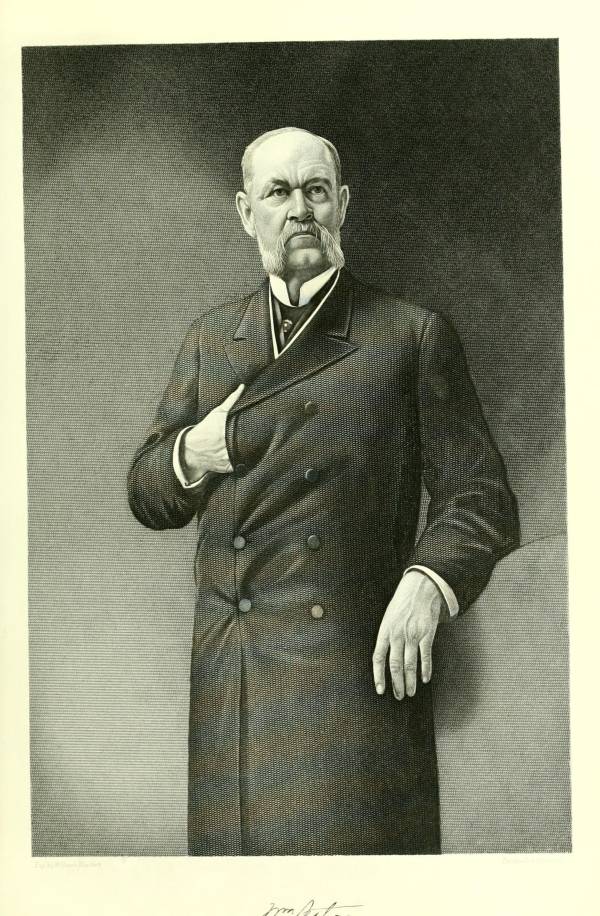 William Backhouse Astor Jr., July 12, 1829 – April 25, 1892, was a businessman, racehorse owner/breeder, yachtsman, and Astor Row in Harlem, NY, the founder who was a member of the prominent Astor family.
William Backhouse Astor Jr., July 12, 1829 – April 25, 1892, was a businessman, racehorse owner/breeder, yachtsman, and Astor Row in Harlem, NY, the founder who was a member of the prominent Astor family.
His elder brother, the financier and philanthropist John Jacob Astor III became head of the British line of Astors in England. William Jr. was head of the American line of Astors, while his wife, Caroline Schermerhorn, served as the leader of New York society’s “Four Hundred” during the Gilded Age.
Early years
William B. Astor, Jr. from New York State’s Prominent and Progressive Men, 1900.
William Backhouse Astor Jr. was born on July 12, 1829, in New York City, New York. He was the middle son of real estate businessman William Backhouse Astor Sr. (1792–1875) and Margaret Rebecca (née Armstrong) Astor (1800–1872).
His siblings included elder brother John Jacob Astor III, who married Charlotte Augusta Gibbes; Emily Astor, who married Samuel Cutler Ward; Laura Eugenia Astor, who married Franklin Hughes Delano; Mary Alida Astor, who married John Carey; Henry Astor, who married Malvina Dinehart; and Sarah Astor, who died in infancy.
Astor’s paternal grandparents were fur-trader John Jacob Astor and Sarah Cox (née Todd) Astor.
His maternal grandparents were U.S. Senator John Armstrong Jr. and Alida (née Livingston) Armstrong of the Livingston family.
Astor Row
Astor Row is the name given to 28-row houses on the south side of West 130th Street, between Fifth and Lenox Avenues in the Harlem neighborhood of New York City, which was among the first speculative townhouses built in the area.
Designed by Charles Buek, the houses were built between 1880 and 1883 in three spurts, on land John Jacob Astor had purchased in 1844 for $10,000. Astor’s grandson, William Backhouse Astor, Jr., was the driving force behind the development.
 The design of the three-story brick, single-family houses is unusual, in that they are set back from the street, and all have front and side yards – an oddity in Harlem, NY – as well as wooden porches.
The design of the three-story brick, single-family houses is unusual, in that they are set back from the street, and all have front and side yards – an oddity in Harlem, NY – as well as wooden porches.
The first group of houses, numbers 8 through 22, comprises freestanding pairs, while the remainder, numbers 24 through 60, are connected together at the rear.
1920 James Cruikshank, an investor, buys 20 houses on Astor Row — all previously owned by middle-class and upper-middle-class whites — and begins selling them to Black buyers, prompting The New York Times to predict that the row would soon be occupied entirely by African Americans.
The Astor Row houses were designated New York City Landmarks on August 11, 1981.
A well-liked man, Astor graduated from Columbia College in 1849.
In his novel Home to Harlem (1928), Claude McKay described Astor Row as “the block beautiful.”
In his novel Home to Harlem (1928), Claude McKay described Astor Row as “the block beautiful.”
Subsequent activity
He supported the abolition of slavery before the American Civil War, and during the war, he personally bore the cost to equip an entire Union Army regiment.
Unlike his business-oriented father, William Jr. did not aggressively pursue an expansion of his inherited fortune. Instead, he preferred life aboard the Ambassadress, at that time the biggest private yacht in the world, or horseback riding at Ferncliff, the large estate he had built on the Hudson River. Astor’s horse “Vagrant” won the 1876 running of the Kentucky Derby.
Florida involvement
William Jr. often spent winters aboard his yacht in Jacksonville, Florida, and he was responsible for the construction of a number of prominent buildings in the city.
He and sixteen other businessmen founded the Florida Yacht Club in Jacksonville in 1876, although he was the only person in Florida to actually own a yacht.
The club is now the oldest social club in Jacksonville and one of the oldest yacht clubs in the United States.
Liking the area, in 1874, he purchased a land tract of around 80,000 acres (320 km2) along the St. Johns River north of Orlando, Florida, in an area now called Lake County, Florida.
There he and two partners used 12,000 acres (49 km2) to build an entire town that he named Manhattan but was later changed to Astor in his honor.
His project, which would come to include several hotels, began with the construction of wharves on the river to accommodate steamboats. These steamboats attracted a steamship agency that could bring in the necessary materials and supplies.
Astor enjoyed his development and purchased a railroad that connected the town to the “Great Lakes Region” of Florida. He donated the town’s first church and the land for the local non-denominational cemetery, and he also helped build a schoolhouse, both of which are still standing today.
In 1875, one of the many nearby lakes was named Lake Schermerhorn after his wife, Lina Schermerhorn.
The town of Manhattan, Florida, boomed, and Astor, with an eye on the large New York market, expanded his interests to a grapefruit grove, a fruit that at the time was only available on a very limited basis in other parts of the United States.
He did not live long enough to see the orchard grow to production. Following his death on April 25, 1892, the property fell to his son Jack. By then though, rapid changes were taking place throughout Florida.
railroads had been built in 1885 through the central and western part of the state, and in the late 1890s, Henry Flagler built a railroad line running down Florida’s east coast from Daytona Beach.
All this expansion left the town of Astor isolated and it was all but abandoned after train service to Astor was discontinued.
Personal life
 On September 23, 1853, he married the socially ambitious Caroline Webster “Lina” Schermerhorn (1830–1908) at Trinity Church in Manhattan.
On September 23, 1853, he married the socially ambitious Caroline Webster “Lina” Schermerhorn (1830–1908) at Trinity Church in Manhattan.
Her parents were Abraham Schermerhorn, a wealthy New York City merchant, and Helen Van Courtlandt (née White) Schermerhorn.
Lina would go on to reign over New York and Newport society known simply as “the Mrs. Astor.”
William Jr. had little interest in society parties, and reportedly, Lina would try to keep him at his club late to prevent him from coming home and sending the orchestra out and his children to bed.
Together, William Jr. and Lina had five children:
Emily Astor (1854–1881), who married sportsman/politician James John Van Alen (1848–1923) and had three children.
Helen Schermerhorn Astor (1855–1893), who married diplomat James Roosevelt “Rosey” Roosevelt (1854–1927), half-brother of President Franklin Delano Roosevelt, and had two children.
Charlotte Augusta Astor (1858–1920), who married James Coleman Drayton (1852–1934) and had four children. They divorced and she later married George Ogilvy Haig (1859–1905).
Caroline Schermerhorn “Carrie” Astor (1861–1948), who married Marshall Orme Wilson (1860–1926),[22] brother of banker Richard Thornton Wilson Jr. and socialite Grace Graham Wilson, and had two sons.
John Jacob “Jack” Astor IV (1864–1912), who married socialite Ava Lowle Willing (1868–1958) and had two children, later married socialite Madeleine Talmage Force (1893–1940), the sister of real estate businesswoman/socialite Katherine Emmons Force, and had one son. He died at the sinking of RMS Titanic in 1912.
William Backhouse Astor Jr. died of an aneurysm at the Hotel Liverpool in Paris, France.
Astor, an Episcopalian, was buried in Trinity Church Cemetery in New York City, New York.
He is one of several responsible for opening up the tourist trade in Florida. His widow died years later in 1908.
Photo credit: 1-3) Wikipedia.
Become a Harlem Insider!
By submitting this form, you are consenting to receive marketing emails from: . You can revoke your consent to receive emails at any time by using the SafeUnsubscribe® link, found at the bottom of every email. Emails are serviced by Constant Contact








